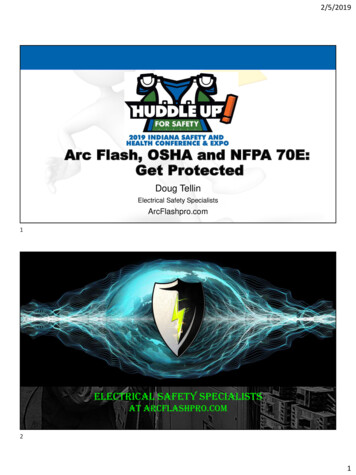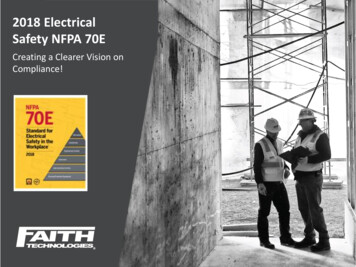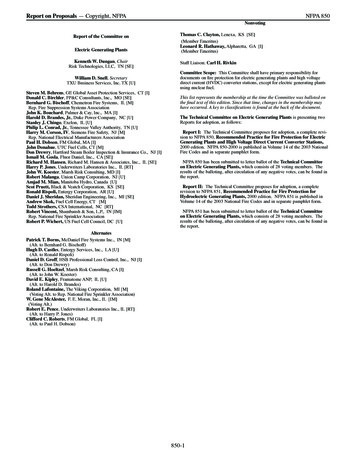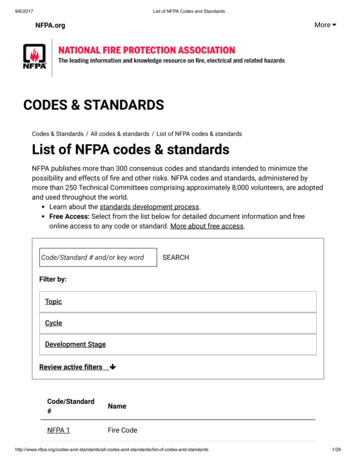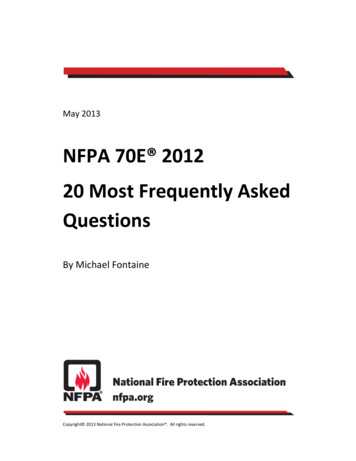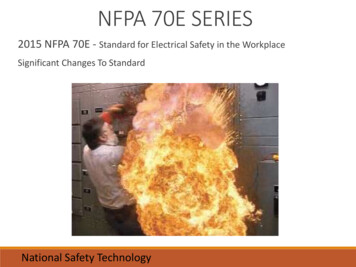
Transcription
Update to theNFPA 70E Standard - 2021 EditionThe Standard for Electrical Safety in the WorkplaceClarifies Provisions for Absence of Voltage Testers Reprinted with permission from NFPA 70E-2021, copyright 2021 National Fire Protection Association,all rights reserved.The numerical designation 70E , Standard for Electrical Safety in the Workplace and the NFPA logo areregistered trademarks of the National Fire Protection Association, Quincy, MA 02169WHITE PAPER
The National Fire Protection Association (NFPA) is a tradeassociation that develops and maintains various standardsand codes designed to prevent injury and economic losscaused by fire and electrical related hazards. The organizationpublishes NFPA 70E, the Standard for Electrical Safety in theWorkplace and updates the standard every three years. Onechange in the latest version, NFPA 70E 2021, includes newlanguage in Article 120.5 (7) providing clarity regarding therequirements to test for the absence of voltage. This whitepaper examines options for absence of voltage testing, thenew language, how different types of products compare, andexplains how the VeriSafe Absence of Voltage Tester (AVT)complies with NFPA 70E requirements.NFPA 70E-2021 Standard for ElectricalSafety in the Workplace.WHITE PAPER – VeriSafe – Update to the NFPA 70E-2021 Standard
More Meaningful ConnectionsMethod for Verifying the Absence of VoltageNFPA 70E, Article 120.5, Process for Establishing and Verifying an Electrically Safe Work Condition, describesa series of steps to verify the absence of voltage after equipment has been de-energized with lockout/tagoutequipment applied.Prior to 2018, the process electrical workers would use to verify the absence of voltage in a panel or otherelectrical equipment required the use of an “ adequately rated test instrument ”, which was not very specific.In 2018 a distinction was made between portable and permanently mounted testers. An exception was added thatincluded specific requirements for permanently mounted absence of voltage testers (AVT). In NFPA standards, anexception is an alternate method to comply with a mandatory requirement. This means that personnel can chooseto use either a portable test instrument or a permanently mounted absence of voltage tester to verify the absenceof voltage, but both methods are not required.With the release of the 2021 edition, Step (7) and the Exception were modified to improve the clarity of therequirements. From NFPA 70E (changes in the 2021 edition are underlined):NFPA 70E-2021 120.5“(7) Use an adequately rated portable test instrument to test each phase conductor or circuit part to test forthe absence of voltage. Test each phase conductor or circuit part both phase-to-phase and phase-to-ground.Before and after each test, determine that the test instrument is operating satisfactorily through verification onany known voltage source.Exception No. 1 to (7): An adequately rated permanently mounted absence of voltage tester shall be permittedto be used to test for the absence of voltage of the conductors or circuit parts at the work location, provided itmeets the all following requirements:(1) It is permanently mounted and installed in accordance with the manufacturer’s instructions and teststhe conductors and circuit parts at the point of work;(2) It is listed and labeled for the purpose of testing for the absence of voltage;(3) It tests each phase conductor or circuit part both phase-to-phase and phase-to-ground;(4) The test device is verified as operating satisfactorily on any known voltage source before and aftertesting for the absence of voltage.Informational Note No. 2: For additional information on rating and design requirements for permanently mountedabsence of voltage testers, refer to UL 1436, Outlet Circuit Testers and Other Similar Indicating Devices.”3WHITE PAPER – VeriSafe – Update to the NFPA 70E-2021 Standard
More Meaningful ConnectionsAlthough Exception No. 1 has been in NFPA 70E since the 2018 edition, recent updates in 2021 add clarity by changing “test device” to “absence of voltage tester.”As the new Informational Note No. 2 states, more information on permanentlymounted AVTs can be found in the product standard for absence of voltage testers, UL 1436. This new reference to UL 1436 is important because of item (2) inException 1 – the requirement to be listed and labeled for the purpose of testing for the absence of voltage. There are several types of permanently mountedproducts, some of which are listed for other purposes, but do not comply withabsence of voltage testing listing requirements. Permanently mounted productsare not all equal so be sure to look for the UL 1436 listing.To further improve readability, terminology was updated to remain consistentwith the rest of the standard. In several instances, “verify” was changed to “testfor” (verify is used to determine if a test instrument is operating properly, whiletesting is used to describe the process of checking for a circuit condition). Similarly, “deenergized” was replaced with “absence of voltage” throughout this section.Meeting Exception 1 of NFPA 70E-2021,Section 120.5 (7)While there are several types of electrical safety products on the market that arepermanently mounted, not all are suitable or for absence of voltage testing. It isimportant to thoroughly examine the features and functionality of each type ofproduct to determine if they satisfy the criteria set forth in NFPA 70E.Voltage Test Portals with a Hand-held Voltage TesterTest portals are permanently mounted devices that can be used with a portable tester, such as a digitalmultimeter, to measure voltage. These devices are an excellent tool for troubleshooting and determiningthe magnitude or value of any voltage that is present.However, using test portals with a portable test instrument can lead to unreliable results when testing forthe absence of voltage and is not recommended. For example, test portals do not meet the requirementsof part (2) of Exception 1—there is no way to confirm that the probes of the hand-held tester are in directcontact with the electrical conductors inside the enclosure at the time of test. If the leads from a voltageportal are not properly terminated or disconnected, voltage will not be detected, regardless of whether ornot the conductor is energized. Often the leads of test portals are fused, resulting in a measurement at theload side of the fuse, not the source conductor. An open fuse will lead to a de-energized measurement,even when voltage is present. Further, although some test portals may be UL listed, they are not listed forthe purpose of verifying the absence of voltage and do not meet part (2) of Exception 1.Test portals are permanently mounted but rely on a portable tester. As a hybrid, test portals would have tomeet the requirements of both Step 7 and Exception No. 1 to ensure a reliable result. The test portal can bethought of as an extension of the circuit part or source conductor – not the actual circuit part. Portals areokay to do a preliminary verification check at the portal. However, before removing PPE or performing anywork, best practice is to perform an additional test with the portable test instrument directly at the sourceconductor or actual circuit part to conclusively prove a de-energized condition exists.Test portals are a great tool to reduce risk when troubleshooting and measuring voltage presence. However, proving absence of voltage through a permanently mounted device has additional requirements thattest portals do not meet.WHITE PAPER – VeriSafe – Update to the NFPA 70E Standard
More Meaningful ConnectionsPanel MeterAlthough it may appear that a panel meter would meet the requirements of Exception 1, the problems liewith part (2), (3), and (4). These do not meet part (2) without a listing for verifying the absence of voltage,such as UL 1436. Part (3) dictates that the tester analyzes each phase from phase-to-ground and phaseto-phase. In-panel voltage meters are hard wired but typically only measure phase-to-ground voltage.A panel meter does not have a self-test function to verify proper operation, required in part (4). A panelmeter checking for voltage may be defective and therefore may not indicate that voltage is presentwhen equipment is energized. Another cause for misindication can occur if one of the sensing leads hasdislodged and is no longer connected to the source. Panel meters can warn of voltage presence, butany indication of absence of voltage is not guaranteed.Voltage IndicatorA voltage indicator is an installed device that illuminates when voltage is present; however, a voltageindicator can be unreliable. When lights on the indicator are off, there could still be voltage if there is ahardware failure, such as the indicator functioning abnormally or if the LEDs fail. Improper installationof a voltage indicator or loose leads can cause the voltage indicator to become disconnected from itssource, resulting in false or unreliable indications. These are some of the reasons why OSHA stated inan Interpretation Letter1 that voltage indicators are not allowed to be used to verify the isolation anddeenergization of a machine or equipment. Regardless of whether electrical or mechanical work will beperformed, voltage indicators are not a test instrument and should not be usedwhen verifying the absence of voltage. Ultimately, voltage indicators do not meetthe requirements for part (2), (3), and (4) of Exception 1.Key featuresAbsence of Voltage Tester (AVT)An AVT differs from other permanently mounted electrical safety products because it is designed specifically to prove the absence of voltage exists. The traditional method of using a portable voltage tester to check for an absence of voltage requires equipment doors to be open to conduct the test. This exposes theelectrical worker to potentially lethal voltages. However, AVTs allow the workerto verify the absence of voltage prior to opening the panel which reduces therisk of an electrical incident.To operate an AVT, a user pushes a button to initiate the test sequence. The testsequence is performed automatically and includes verifying the tester is functioning with a known voltage source, ensuring the tester is properly installed andin direct contact with the circuit at the time of testing, and testing for absence ofAC and DC voltage phase-to-phase and phase-to-ground. If all requirements inthe test sequence are satisfied, a green indicator will illuminate to visually conveythat the absence of voltage has been confirmed.All AVTs use active indicators to visually convey that voltage is not present. Asan additional safety feature, some testers such as the VeriSafe AVT incorporatevoltage indicators to show when voltage is present, similar to a voltage indicator. Requirements in UL 1436 for AVTs are very extensive and include a variety offeatures to ensure the absence of voltage test function is fail-safe and reliable.Active indicators, built-in overcurrent protection, and SIL 3 reliability for all safetyfunctions are some of the important features. In addition, AVTs are designed tokeep hazardous voltage away from the door and user interface.of an AVT Tests without exposure toharmful voltages Self-contained; no need foradditional meters or tools Built-in pre-/post-verificationtest Verification that the tester is incontact with the circuit beforeand after every test Tests for absence of AC andDC voltage Tests phase-to-phase andphase-to-ground Automated test sequence Active indication for absenceof voltage Safety functions meet safetyintegrity level (SIL) 3 per IEC615082Galassi, T. (2012, December 12). Whether an LED type device can be used for the isolation and deenergization verification requirements of 1910.147 and 1910.333. Retrievedfrom https://www.osha.gov/laws-regs/ s-regs/standardinterpretations/2012-12-12.1IEC 61508 Functional Safety of Electrical/Electronic/Programmable Electronic Safety-related Systems.25WHITE PAPER – VeriSafe – Update to the NFPA 70E-2021 Standard
More Meaningful ConnectionsProduct ComparisonTable 1 shows a side-by-side comparison on how permanently mounted products including voltage meters,voltage indicators, test portals, and the VeriSafe AVT perform with respect to the requirements in Exception 1.Only the VeriSafe AVT meets all of the requirements for verifying the absence of voltage.Table 1. Comparison of Products and CapabilitiesNFPA 70E-2021 120.5 (7)Exception No. 1PanelMeterVoltageIndicatorVoltage TestPortalsVeriSafeAVTYesYesYesYesN/A(no testfunction)N/A(no testfunction)No(no guaranteehand-held tester is incontact with circuit)YesIt is permanently mounted and installedin accordance with the manufacturer’sinstructions(1)and tests the conductors and circuitparts at the point of work(2)It is listed and labeled for the purpose oftesting for the absence of voltageNoNoNoYesIt tests each phase conductor or circuitpart both phase-to-phase and phaseto-groundOnly phaseto-groundOnly phaseto-groundYes, withhand-held testerYes(3)The test device is verified as operatingsatisfactorily on any known voltagesource before and after testing for theabsence of voltageNoNoNo(hand-held testerrequires access to aknown voltage source)YesNoNoNoYes(4)Meets rating and design requirementsNote for absence of voltage testers described1in UL 14366WHITE PAPER – VeriSafe – Update to the NFPA 70E-2021 Standard
More Meaningful ConnectionsVeriSafe AVT – The Safe, Efficient, Reliable Way to VerifyWhen servicing electrical equipment, workers must comply with safety regulations that require a test to confirm theabsence of voltage. Prior to performing de-energized workon electrical equipment, NFPA 70E requires that workersverify equipment is in an electrically safe work condition.Permanently mounted testers, like the VeriSafe AVT maketesting for absence of voltage safer and more efficient.The VeriSafe AVT is the first absence of voltage tester listedto UL 1436 designed specifically for the requirements ofNFPA 70E-2021, Section 120.5 (7), Exception 1.The VeriSafe AVT tests for absence of voltage in low voltage electrical enclosures, helps reduce electrical hazards andthe complexity of testing with a hand-held tester, and is more reliable than a simple voltage indicator or meter.Visit http://www.panduit.com/verisafe for more information.What Happens During an AVT Test?7WHITE PAPER – VeriSafe – Update to the NFPA 70E-2021 Standard
Since 1955, Panduit’s culture of curiosity and passion for problem solving have enabled more meaningful connections between companies’business goals and their marketplace success. Panduit creates leading-edge physical, electrical, and network infrastructure solutions forenterprise-wide environments, from the data center to the telecom room, from the desktop to the plant floor. Headquartered inTinley Park, IL, USA and operating in 112 global locations, Panduit’s proven reputation for quality and technology leadership,coupled with a robust partner ecosystem, help support, sustain, and empower business growth in a connected world.For more informationVisit us at www.panduit.com/verisafeContact Panduit North America Customer Service by email: cs@panduit.comor by phone: 800.777.3300THE INFORMATION CONTAINED IN THIS WHITE PAPER IS INTENDED AS A GUIDE FOR USE BY PERSONS HAVING TECHNICAL SKILL AT THEIR OWN DISCRETION AND RISK. BEFORE USING ANYPANDUIT PRODUCT, THE BUYER MUST DETERMINE THE SUITABILITY OF THE PRODUCT FOR HIS/HER INTENDED USE AND BUYER ASSUMES ALL RISK AND LIABILITY WHATSOEVER IN CONNECTIONTHEREWITH. PANDUIT DISCLAIMS ANY LIABILITY ARISING FROM ANY INFORMATION CONTAINED HEREIN OR FOR ABSENCE OF THE SAME.All Panduit products are subject to the terms, conditions, and limitations of its then current Limited Product Warranty, which can be found at www.panduit.com/warranty.* All trademarks, service marks, trade names, product names, and logos appearing in this document are the property of their respective owners.PANDUIT US/CANADAPhone: 800.777.3300PANDUIT EUROPE LTD.London, UKcs-emea@panduit.comPhone: 44.20.8601.7200PANDUIT SINGAPORE PTE. LTD.Republic of Singaporecs-ap@panduit.comPhone: 65.6305.7575PANDUIT JAPANTokyo, Japancs-japan@panduit.comPhone: 81.3.6863.6000PANDUIT LATIN AMERICAGuadalajara, Mexicocs-la@panduit.comPhone: 52.33.3777.6000PANDUIT AUSTRALIA PTY. LTD.Victoria, Australiacs-aus@panduit.comPhone: 61.3.9794.9020 2020 Panduit Corp. ALL RIGHTS RESERVED.SFAT11--WW-ENG replaces SFAT04--SA-ENG 09/2020
The National Fire Protection Association (NFPA) is a trade association that develops and maintains various standards and codes designed to prevent injury and economic loss caused by fire and electrical related hazards. The organization publishes NFPA 70E, the Standard for Electrical Safety
